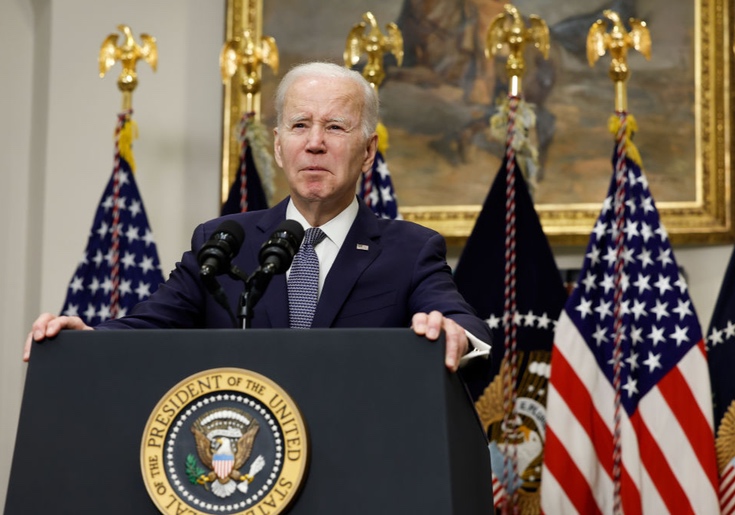To recap: On March 8, Silicon Valley Bank of Santa Clara, California, announced that its balance sheet was weak. The bank held around $175 billion in deposits. They needed to raise capital, but its management had parked too much money in long-term government bonds. At the time of purchase, in a low-interest rate environment, those bonds had seemed safe. Then inflation arrived. Rates went up. Silicon Valley Bank was forced to sell the treasuries at a $1.8 billion loss.
The next day, March 9, panic began to spread. Ratings agencies downgraded Silicon Valley Bank’s credit. Its stock plunged. A run on the bank—with depositors demanding their money back—took off. On March 10, Silicon Valley Bank collapsed.
Silicon Valley Bank is the largest financial institution to go under since the Global Financial Crisis in 2008. Its sudden demise shocked investors into reexamining the financial sector. The largest banks may rest on firm capital cushions. What about regional banks? Fear of instability caused depositors to flee these midsized firms. Shareholders did too. Signature Bank of New York was caught in the whirlpool. It drowned.
To stop the contagion from spreading further, on Sunday, March 12, Treasury Secretary Janet Yellen, Martin Gruenberg of the Federal Deposit Insurance Corporation, and Federal Reserve chairman Jerome Powell made the following announcement: The federal government would guarantee deposits at Signature and Silicon Valley Bank. Until last weekend, the FDIC insured deposits up to $250,000. No longer. The ceiling was blown away in a cyclone of panic.
President Joe Biden was quick to assert that the backstop is different from the Troubled Assets Recovery Program, or TARP, the controversial bank bailout of 2008. The new Federal Reserve facility won’t support creditors or shareholders or executives, just depositors. And tax revenue won’t pay for the guarantee directly, an FDIC fee will—a fee levied on banks and passed on to consumers, who also happen to be taxpayers.
Biden and Yellen won’t say it’s a bailout. Of course it’s a bailout. In some ways this bailout is worse than in 2008. After all, Congress passed TARP. Congress is a bystander here. And TARP set economy-wide rules and qualifications. Biden’s intervention is discretionary and selective. When she appeared before Congress on March 16, Yellen admitted that the unlimited deposit guarantee doesn’t apply to every bank. It applies to systemically important banks. Who decides which bank is systemically important? She does. As circumstances dictate.
Yellen tried to sooth Congress. She tried to project strength. "I can reassure the members of the committee that our banking system is sound, and that Americans can feel confident that their deposits will be there when they need them," she told Senate Finance. "This week’s actions demonstrate our resolute commitment to ensure that our financial system remains strong and depositors’ savings remain safe."
Feel better?
Authorities have struck similar notes of confidence during previous emergencies—the pandemic, the crash of 2008, the first hours of September 11, 2001. Subsequent events proved them wrong. Yellen and Biden may end up looking just as foolish. They are playing Whack-A-Mole, concentrating on financial varmints as they pop up. They should be addressing underlying causes.
The chaos in the banking system is the result of decades of low to zero interest rates and $6 trillion in fiscal stimulus since 2020. That flood of money and credit produced the worst inflation in four decades. In 2022 the Federal Reserve began raising interest rates to restore price stability. The Fed should have acted sooner. It waited because it assumed that inflation would be temporary.
That assumption was false. The Fed’s complacency made the situation worse. By the time it started raising rates, inflation expectations were fixed. The past year of Fed hikes may have slowed inflation. What they haven’t done is kill it.
Biden, Yellen, and the Federal Reserve want a "soft landing." They are after a magic formula that will quell inflation and avoid a recession. They will be disappointed. No one likes inflation: It lowers the standard of living. But the Federal Reserve’s solution—a contraction of the money supply through higher interest rates—is nasty too. High interest rates can cause a recession. Or something worse.
Now Biden and the Fed are caught in a stimulus trap: Higher interest rates increase the likelihood of financial instability, while keeping rates pat—or cutting them—will prolong the inflation. Doing nothing will perpetuate the current mix of declining standards of living amidst periodic chaos.
Biden has ruled out other options. Supply-side measures such as deregulating energy and reducing means-tested income transfers are off the table. Legal immigration won't be made easier. Trade barriers won’t be reduced.
Biden, Yellen, and Powell have gifted America with another "emergency" measure that will last long after the crisis subsides. Republicans are eager for a piece of the action—why do Gavin Newsom and Silicon Valley tech giants get this guarantee, while midsized banks in rural areas do not?
Rather than limit and sunset the deposit backstop, enforce market discipline, and reassert the Fed’s commitment to price stability, the same team that brought America the worst inflation in a generation is entangling itself further in a key sector of the economy. It would be foolish to trust in their judgment. Look at the record. Practical wisdom is scarce in an administration populated by academics and partisan fixers.
Soft landing? Afraid not. Brace for impact.
